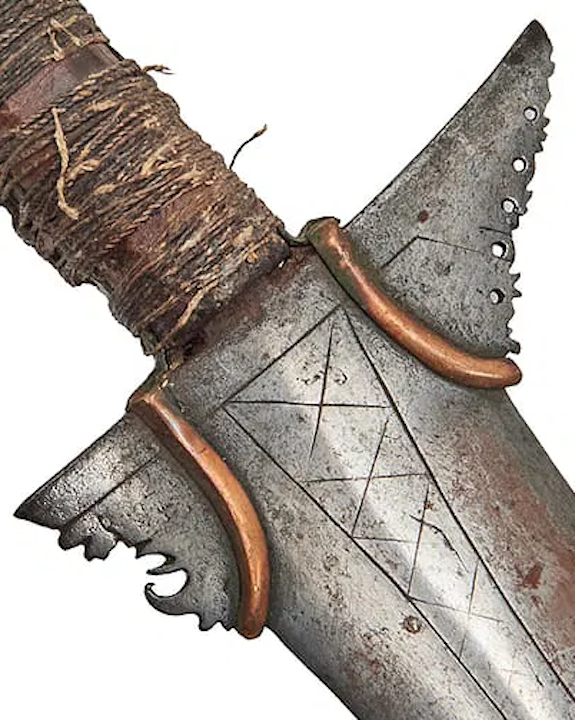 2nd November 2025, 05:10 AM
2nd November 2025, 05:10 AM
|
#1
|
|
Vikingsword Staff
Join Date: Dec 2004
Location: The Aussie Bush
Posts: 4,618
|
 Two unusual Moro kris
Two unusual Moro kris
These two kris were sold together recently at auction. They are not mine, but I thought they were somewhat unusual and worthy of showing here to provide further information for our archives. I have labeled them A and B for reference.
Example A: I would place this one as late 19th-early 20th C based on the blade with rather shallow waves (luk). The carving of the elephant trunk area, which is crude, also seems to reflect that period. The slight angle to the tusk suggests a Sulu origin. I think the gangya is separate, but would need closer inspection in hand to be sure.

All we have of the dress are the hilt and baca baca (no scabbard), which nevertheless I think are interesting. The grip is a non-descript wrap with cord, a utilitarian and inexpensive wrap for a sword meant to be used. The two baca baca are made from a copper alloy, another inexpensive material. The pommel is a simple horse hoof design, but which is quite abruptly angled downwards. That angle is uncommon on Tausug hilts, but might suggest a Yakan origin because such angled pommels were favored on 20th C pira. Other possibilities might be Palawano or northen Borneo, both of which have historical connections to the Sulu Archipelago. Adoption of the sword by another ethnic group, such as one of the Lumad tribes, might also be a possibility.
Example B is even more strange. The blade appears to be 20th C in manufacture, and I believe that the gangya is not separate. Curiously, the line of demarcation between the gangya and blade is curved and the gangya is very narrow on the greneng side. Although the blade looks Moro for the most part, the gangya and greneng are highly atypical.
The hilt is again unusual for its downward tilted wooden pommel. The possibilities mentioned above may apply here also. The grip is also unusual for its copper wire wrap, flanked by two woven strips of rattan.
I'm struggling to place which ethnic group this one may be associated with. Perhaps Palawano or northern Borneo, Lumad, or even Visayan.
As always, your comments and thoughts are most welcome.
Last edited by Ian; 2nd November 2025 at 06:04 AM.
|

|

|